Red Sea 2024
Christmas & New Year's Eve
Last Minute Offer!
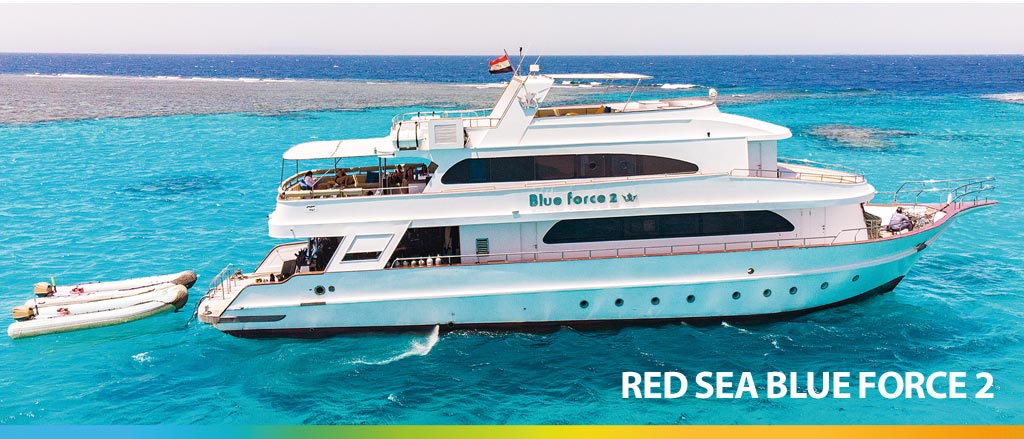
Don’t miss the Last Minute Offer!
Schedule with available places and discounts
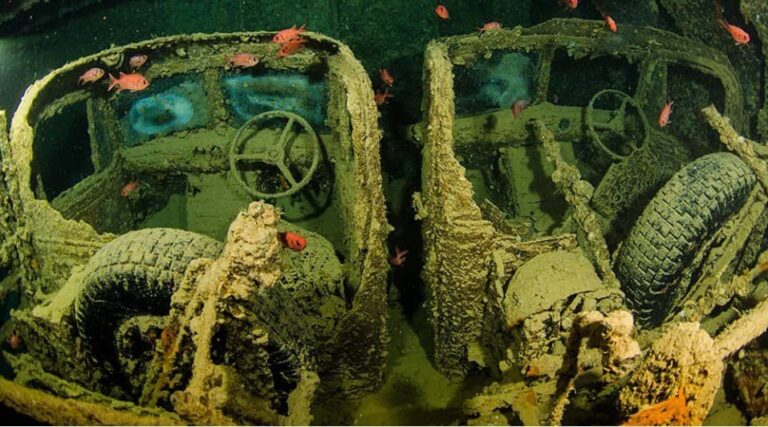
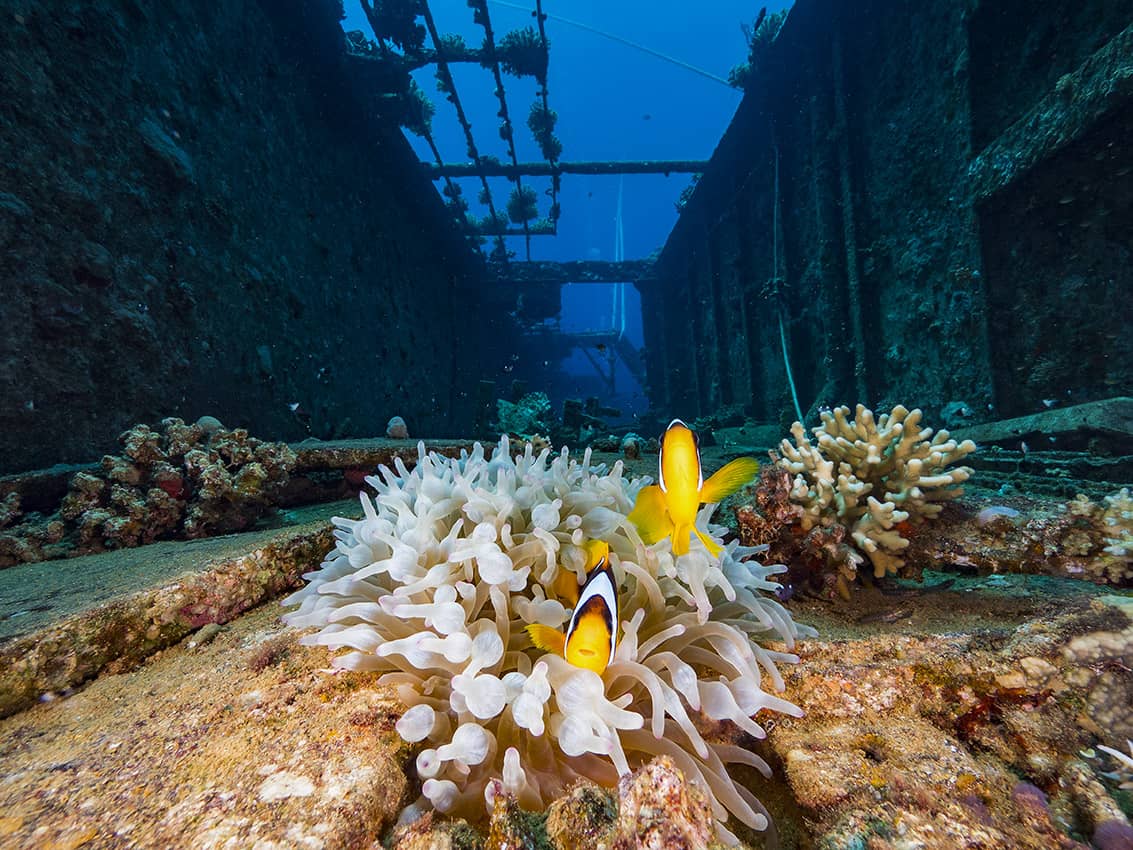


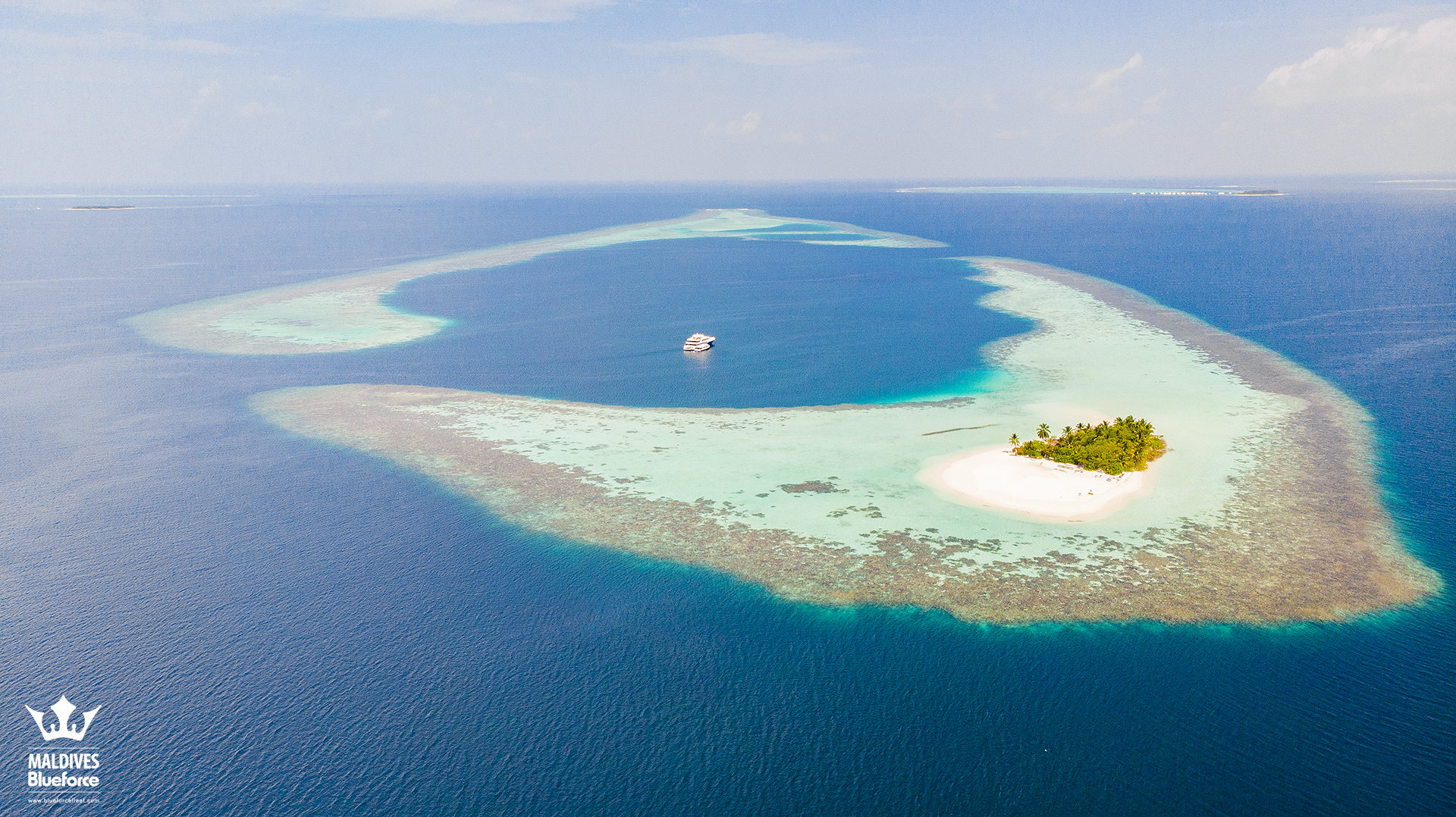
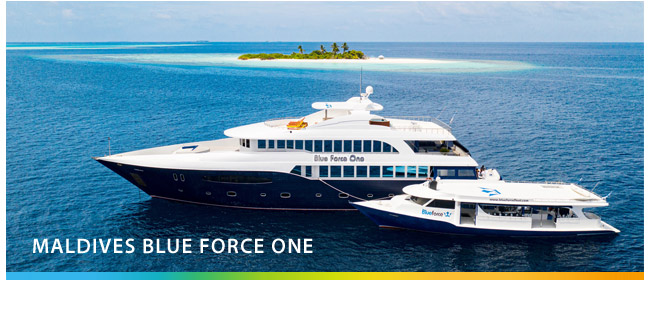
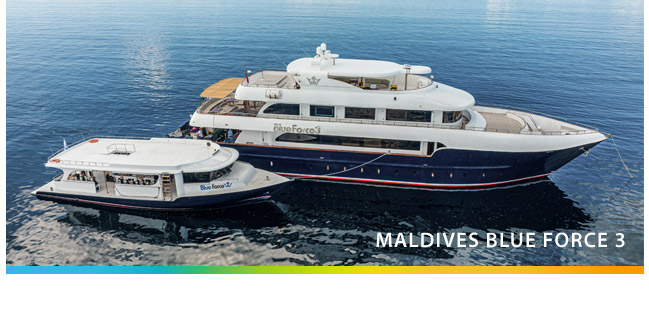
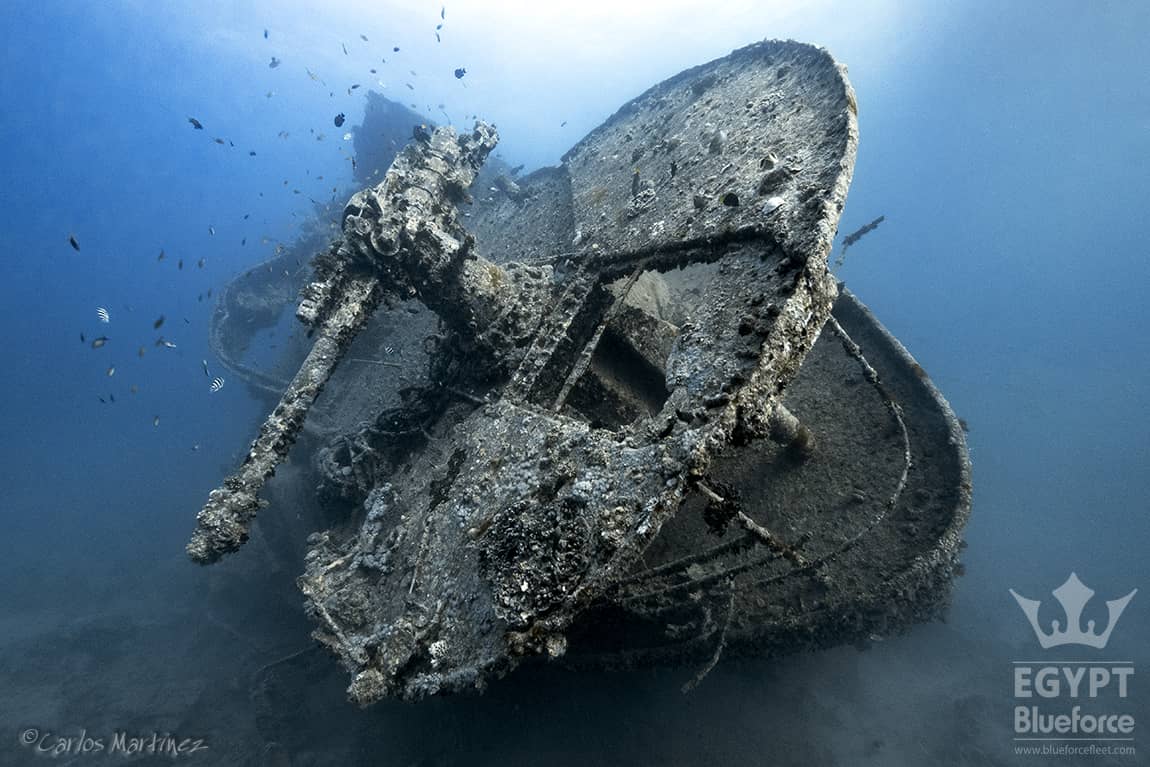
The remains of the Thistlegorm wreck have become a place of pilgrimage for all divers in the world. Shipwreck lovers from all over the world can’t help but travel to the Egyptian Red Sea again and again to visit this submerged wonder.
A series of wonderful coincidences and circumstances turned its remains into a perfect place for any type of diver. This is why the Thistlegorm is, today, one of the best wrecks for recreational diving worldwide.
During World War II, Axis troops occupied the Mediterranean. German U-boats awaited convoys of supply ships at the entrance to the Straits of Gibraltar and planes patrolled from the southern Italian islands looking for prey to attack. The only safe way to resupply Allied troops in North Africa was to go around the African continent and enter the Red Sea.
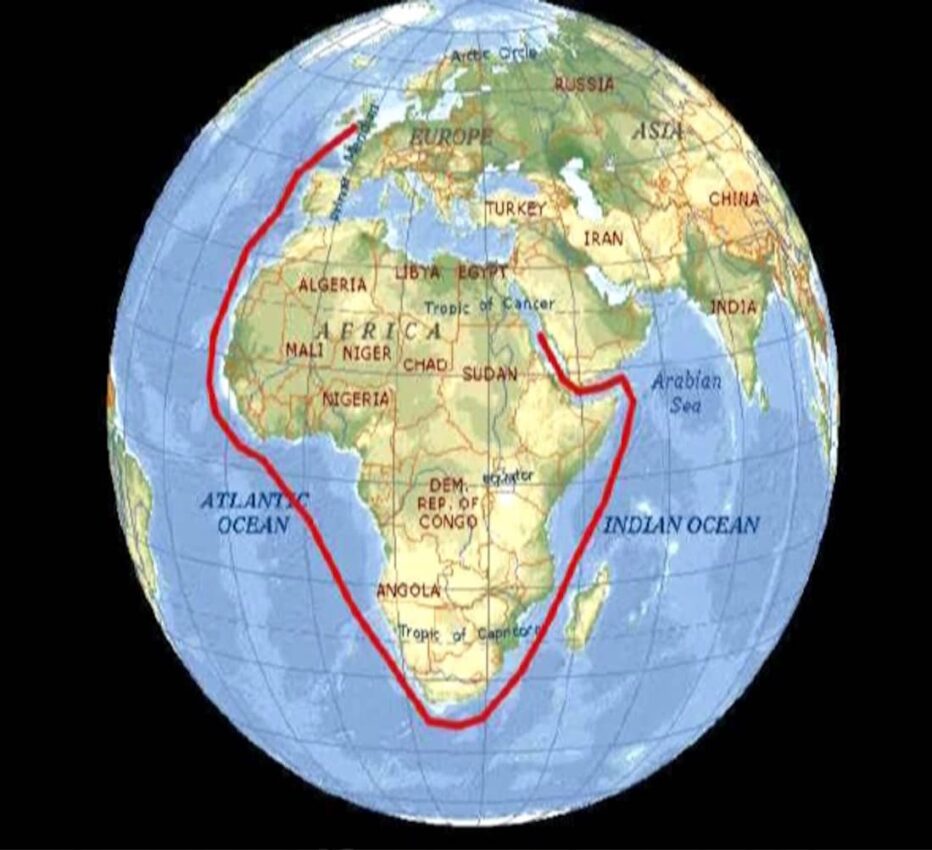
Both the supply of material and that of troops were carried out using this alternative route.
The SS Thistlegorm leaves the port of Glasgow on June 2, 1941, in the direction of Alexandria, and after several weeks of a long journey, she manages to reach the Egyptian waters of the Red Sea safe and sound.
But not everything was going to be a bed of roses for our protagonist… another allied ship traveling the same route had collided, a few days before, with a submerged mine at the entrance to the Suez Canal, preventing the passage of the other convoys.
The Captain of the SS Thistlegorm, William Ellis, is ordered to anchor his ship in one of the safe zones established for this type of situation at the Egyptian Red Sea, the safe zone in the lagoon of Shaab Ali, in front of the Sinai Peninsula.
Built-in North East England in 1940 and sunk by German bomber aircraft in the Red Sea in 1941
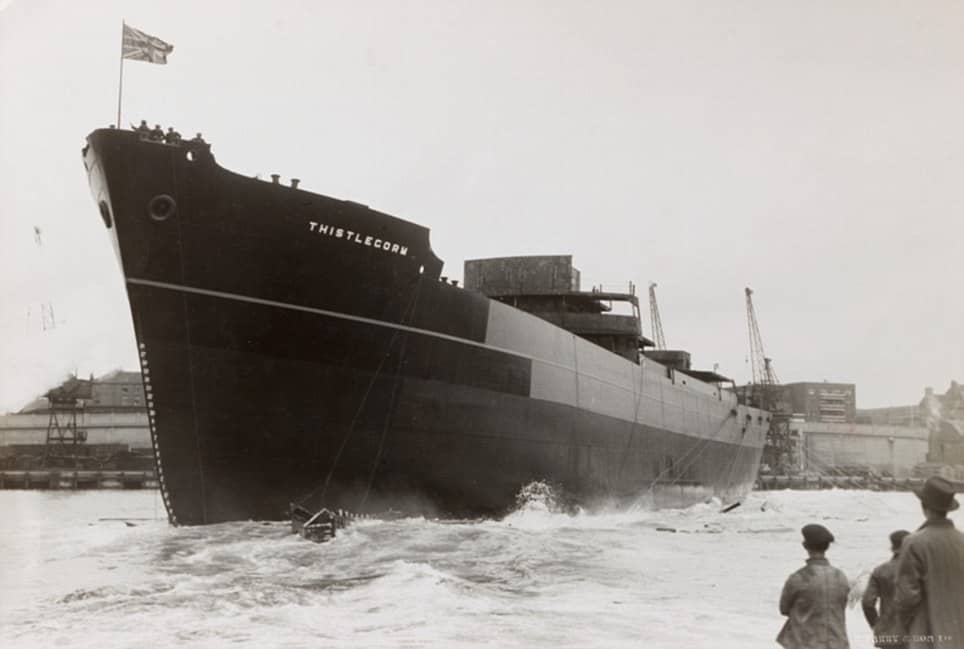
Meanwhile, the Germans had not ceased in their efforts to cut off enemy supply. His spies had reported that the largest cruiser in the British fleet, the Queen Mary, was headed with thousands of soldiers to North Africa, following the same route as the SS Thistlegorm. A great trophy for any of the German pilots eager for recognition and honors for which they had decided to lighten their planes, load fewer bombs and more fuel, and thus extend the range of their patrols.
On the night of October 6, 1941, 2 Heinkel He 111 bombers on patrol in the area looking for the Queen Mary, spotted the lights of a ship and decided to drop their bombs, one of them entering the ammunition hold of the Thistlegorm and sinking it in a few minutes together with 9 of his crew.
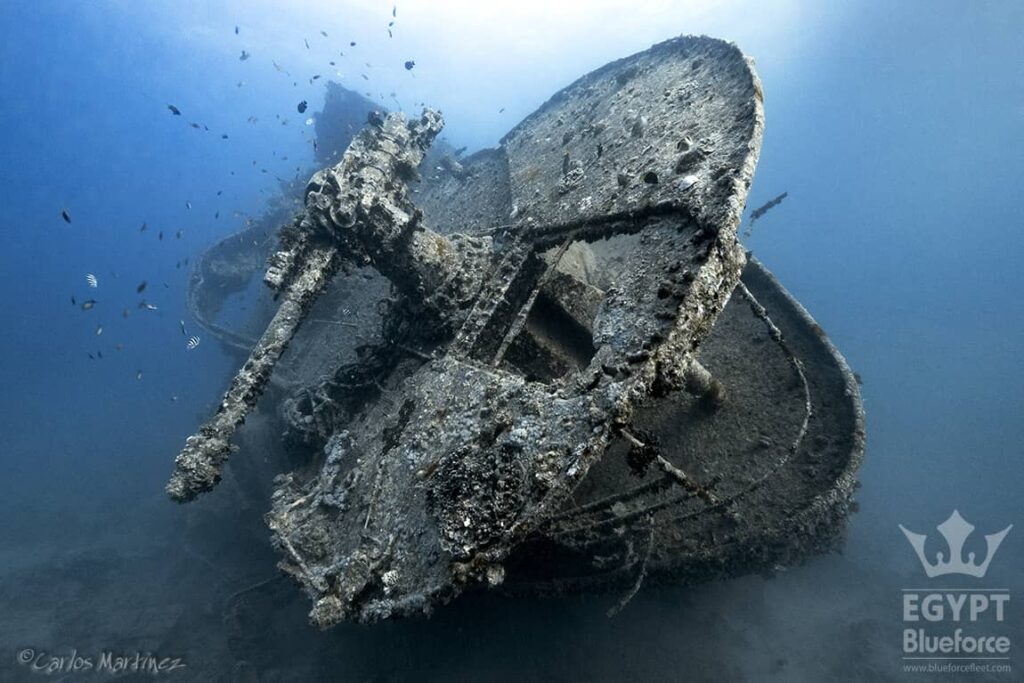
Shipwrecks attract divers and it is probably due to the mystery behind the sinking of an artifact that was made to float and navigate. If we add a tragedy and some historical problems, it has all the ingredients to become a good dive site that will attract many divers.
After almost 10 years of resting under the sea, an expedition led by Commander Jacques Cousteau investigated the wreck, after interviewing some fishermen in the area, and obtained the approximate position of the sinking site.
Today, the SS Thistlegorm dive site is so popular that you cannot say that you have been to the northern Red Sea and not dived on it. The Blue Force fleet has many cruise routes in the area that include a visit to the wreck.
The boat is 32 m deep on a sandy bottom near the reef. The shallowest parts of the wreck are between 16 and 18 m deep. The dive is not difficult, but it should not be considered a beginner’s site, because some of the most iconic and interesting sections of the wreck are below deck, in the holds, which means diving under the roof. The still recognizable motorcycles and trucks are some of the most impressive sights on this site. We have seen many images of them but seeing them in person is unforgettable. Life on the wreck is abundant with many lionfish filling the shaded parts of the wreck. Large crocodile fish are easily seen on deck. Visibility is good depending on the season, ranging between 18 and 30 m.
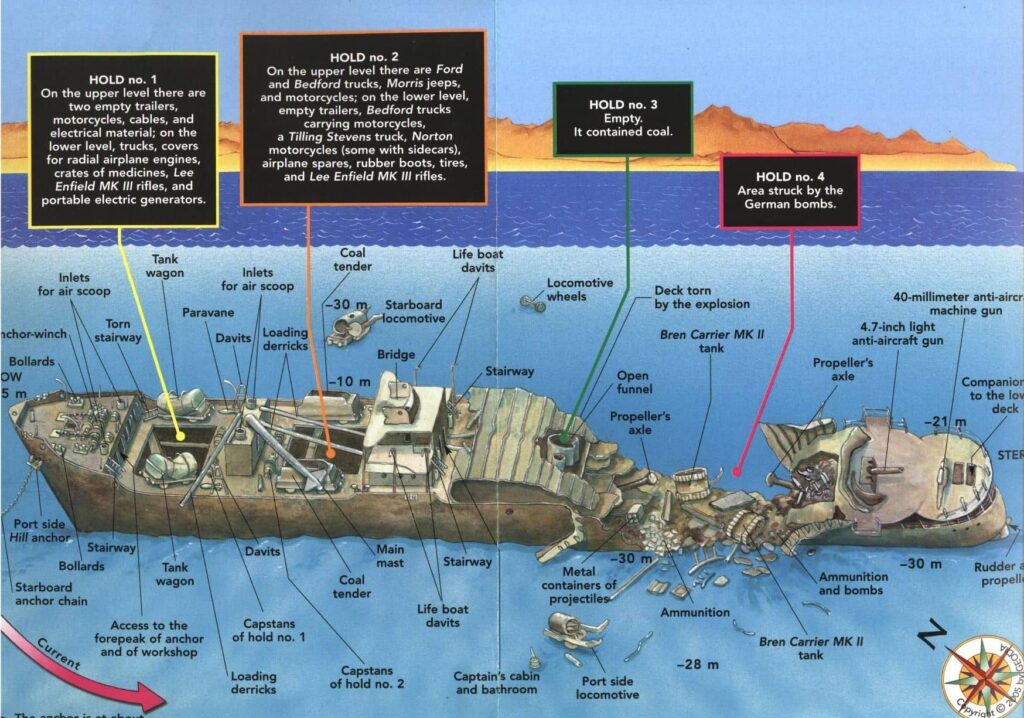
The ease of access to its holds, the possibility of going from one to another while observing its content and its variety have turned this shipwreck into a submerged museum about the Second World War.
When you go down to the ship and see it from the outside you can see the crew cannons, a locomotive, the destruction of the bombs, and the Bren Gun Carrier tanks supporting the infantry, they are belly up showing their chains. From there we can begin to introduce ourselves between the lines of trucks and motorcycles and reach the warehouse of rifles and aircraft parts such as wings that are still preserved. In warehouse number two we will find more trucks and see BSA M20 motorcycles assigned to Field Marshal Auchinleck, who was in charge of the British troops fighting Rommel. The G3L was designed specifically to be used in the desert and the Norton 16H.
We can also see Bedford MW and OY trucks, built for supplying troops. The Morris Commercial CS8 for artillery transport, the large Ford WOT 2 and 3, and the Tilling Stevens TS19.
For more than 25 years, all our routes in the Sinai area spend a day diving into the SS Thistlegorm wreck. Normally you arrive in the afternoon when the rest of the boats return to the port and take the opportunity to dive at sunset and another at night.
The next morning we dive again to explore the ship again so that no area is left unvisited.
From March to January you can dive into this place, just check the availability of the routes on our website.
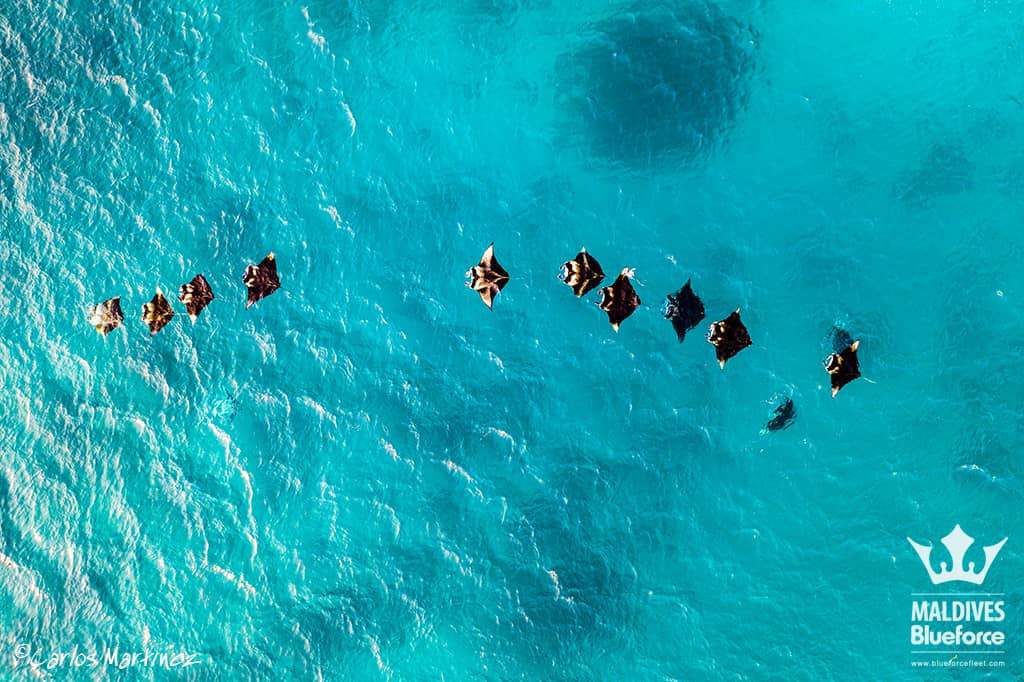
One manta ray, two manta rays, three manta rays, … and so and so counting up to six, seven, or eight together in a single dive site is common on a trip to the Maldives. But when the count starts to hit forty or fifty and it’s literally impossible to keep calculating the exact number of manta rays swimming in all directions, you can only be in one place: Hanifaru Bay.
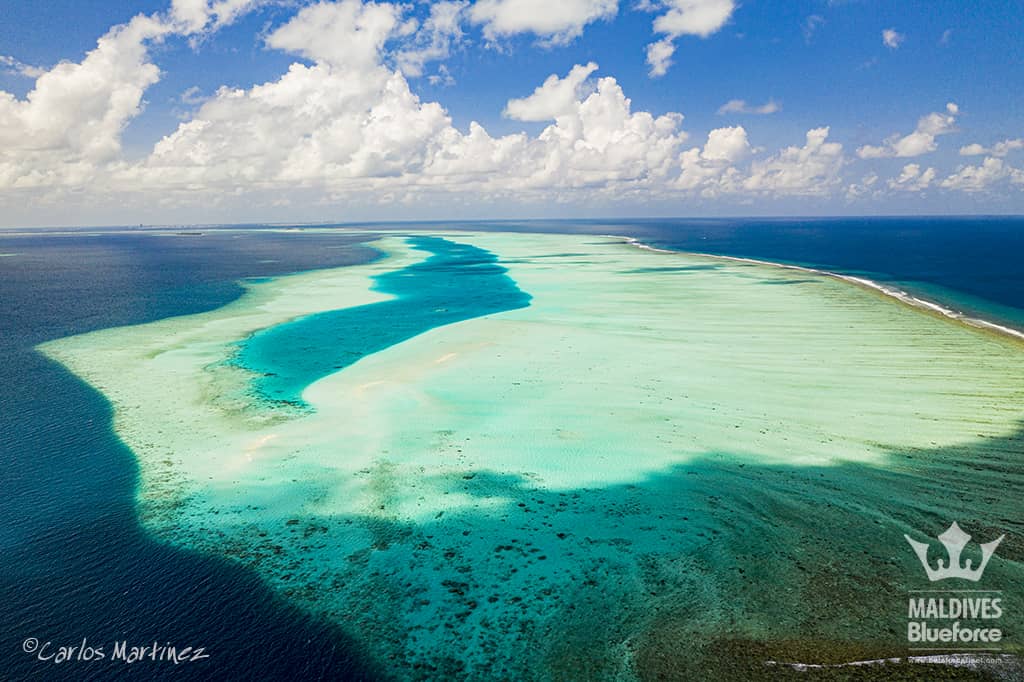
Hanifaru Bay, in the Maldives, is a unique place in the world, the shape of the bay and certain ocean currents that converge for a short period of time, favor the concentration of huge amounts of plankton and this allows us to contemplate one of the largest agglomerations of reef manta rays (Mobula alfredi) with an average size of 2-3 m. only surpassed by the giant oceanic manta (Mobula birostris) that can reach more than 5m. of wingspan
Logically, after the discovery of the place by a scientific team, in a few years, Hanifaru Bay became one of the main attractions of the north of Maldives, not only because of the huge amount of mantas that at some times can be observed but also by a growing number of whale sharks that also take advantage of the large amounts of food in the form of plankton found here. To avoid a more than likely overcrowding, in 2011 UNESCO declared Baa Atoll, and especially Hanifaru Bay, a Biosphere Reserve.
Subsequently, the government of the archipelago established strict regulations and supported scientific projects that are still being developed here and in other areas of the Maldives related to this species. Time has shown the success of such measures with the progressive increase in the number of specimens sighted.
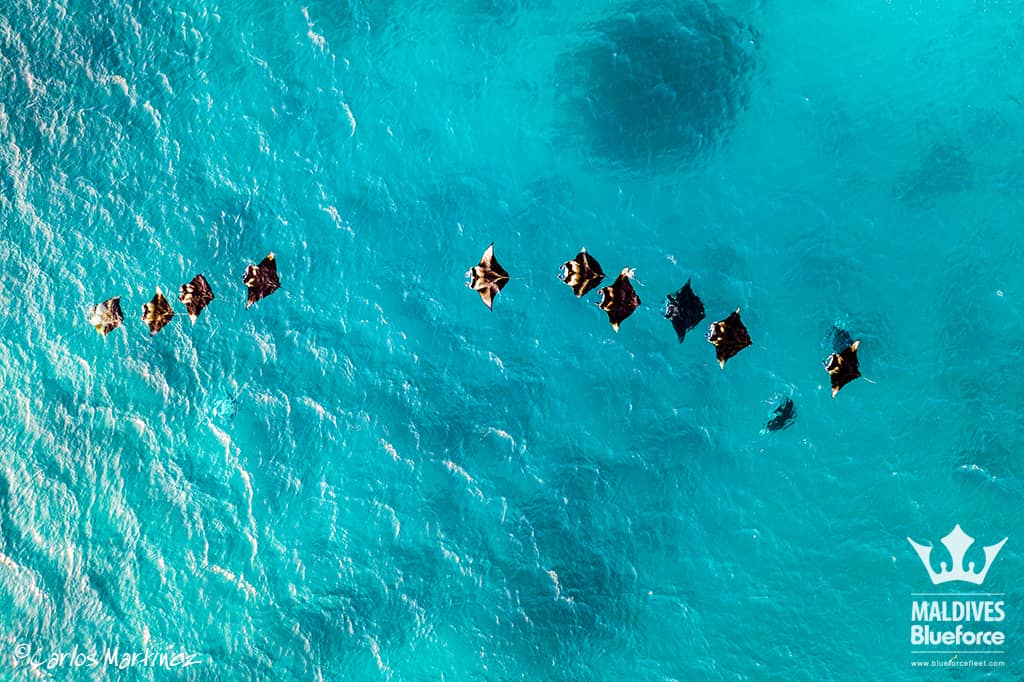
Only snorkeling is allowed to swim with these giants in the famous bay. Divers and bubbles would clearly affect the behavior and feeding in a continuous movement of the mantas. Not forgetting that after a few minutes in the water one realizes that scuba diving would not be the best option to enjoy the spectacle that takes place so close to the surface.
From the beginning, the liveaboard cruises do not freely access the area of the atoll where the mantas feed, trying to avoid disturbing the animals and avoid the decrease of specimens in the area, in addition to paying a fee to contribute to the maintenance of the reserve. Visitors, before accessing the water, must attend to the detailed instructions provided by the Manta Trust team and the reserve rangers on how to act at all times, in limited groups, and under the supervision of a certified local guide. Although it may seem somewhat restrictive, shortly thereafter and without any effort, the mantas always end up swimming close, even very close, to anyone who respects their space and their way of eating, either collectively “in a row” or individually performing loopings incessantly.
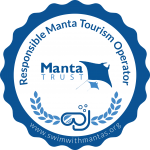
We are happy to be a “Manta Trust Responsible Tourism Operator” working with the Manta Trust Organization with their program “Swim with Mantas“
You have to be calm and observe the route that the mantas make uninterruptedly along the canal. The comings and goings are constant, so even in a short time, you can come to recognize some individuals with unmistakable marks such as spots or even bites, some of them healed but others also recent.
Some tips to enjoy the experience:
Do not chase the mantas and let them get used / close
Flashes and video lights are not allowed, but their use would not be useful either.
Always stay close to the surface and enjoy such a wonderful spectacle as one more spectator.
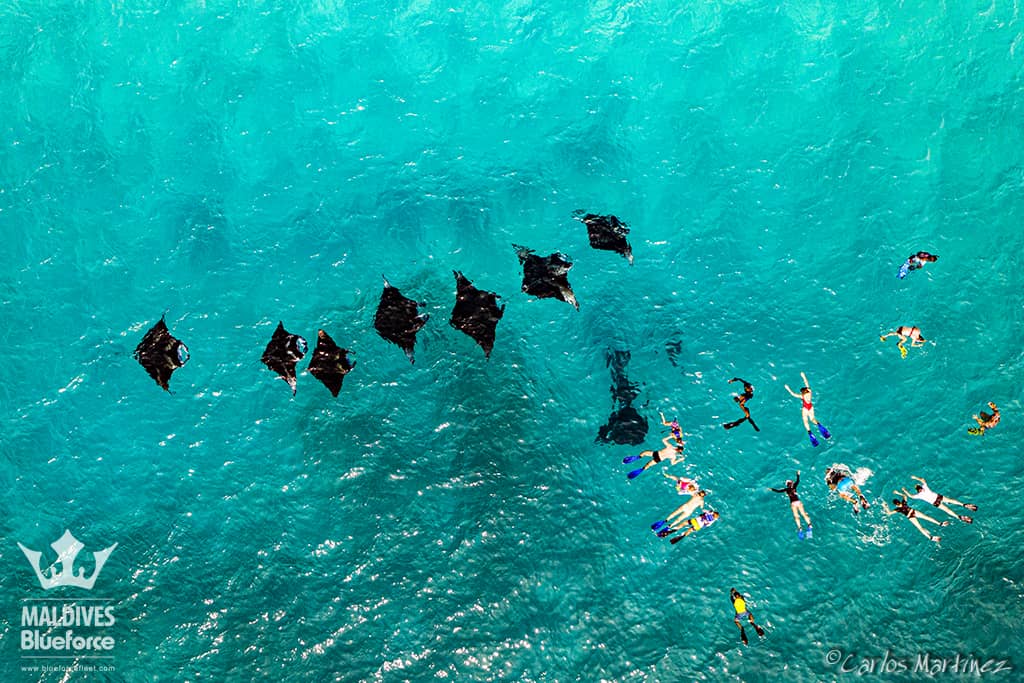
Although the main restrictions are established for Hanifaru Bay, in the other areas of Baa Atoll diving is allowed. So many congregations of individuals feeding in the bay explain a large number of sightings by divers outside the atoll, not only of mantas but also, with a bit of luck, of whale sharks. In the area there are no great diving spots or those with a special interest, so a day is usually spent in the area to be able to enjoy other atolls.
The “official” season in Hanifaru is from May to November, although the largest congregations of mantas usually occur between the months of July and October. Ideally, choose a route combining the best of the central atolls and a visit to the Baa atoll, further north of the well-known central atolls.
Our recommendation is the Manta Expedition, a route that visits the North Male atolls, visiting the first manta cleaning stations and the famous Fish Factory, Baa Atoll, where we will dive in the Dharavandhoo area, next to the Hanifaru Bay (UNESCO Biosphere Reserve), where we will try to enjoy the mantas while snorkeling, to continue with Rasdhoo Atoll, where pelagic fish await us, Ari Atoll where we will dive with mantas at night and some of the most spectacular thilas, and as a final touch the Vaavu Atoll with its famous and unique dive with the nurse sharks on the island of Alimathaa.
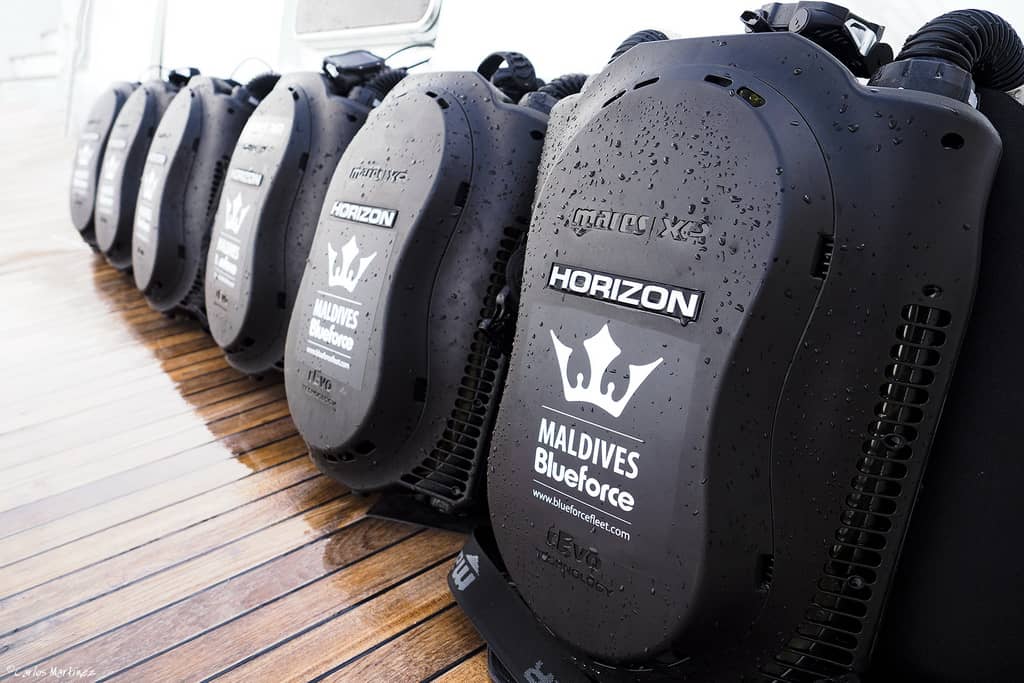
A unique special cruise to test the Mares HORIZON rebreather
Be the first diving in Maldives with this awesome equipment
Onboard MALDIVES BLUE FORCE ONE (considered as one of the best diving Liveaboard in the world) we propose you the CENTRAL ATOLLS ROUTE from January, 15th to 22nd & 22nd to 29th, 2022.
This is the best well-known route in the Maldives but at the same time the one that offers the best and most varied dives. We do this route almost all year long (from August to May) week after week. Thanks to that, we know every detail, atoll, passage, thilas, and where and when it is convenient to approach every dive zone.
It is a 7-night route including 6-dive days on board with embarkation and disembarkation at Male Airport (18 dives with 2-night dives).
The habitual itinerary goes by North and South Male Atolls, Vaavu, and Ari.
The aim is to find pelagic, grey sharks, white-tip sharks, black-tip sharks, and in some cases hammerheads and dolphins, eagle rays, and schools of colorful fishes, morays, tuna fish, groupers, and turtles.
Drifting dive in water channels, thilas (submerged coral “seamounts”), cleaning stations where big mantas gather to deworm themselves, will search for the whale shark (and if we are lucky will snorkel and even dive with the biggest fish). We will dive into a full-of-life wreck. Besides, there will be two spectacular night dives, one with mantas and the other with dozens of nurse sharks.
Desert islands are also visited to discover and enjoy a bit more of the country and if the weather allows doing so we will even BBQ on a beach.
During this week, we will be able to discover and test the new semi-closed rebreather HORIZON SCR from MARES.
Although if you are longing to relax, you can enjoy the solarium and the jacuzzi on board, kayak, Paddle SUP…
All this will make this cruise an excellent and unforgettable Great Dive Travel.
